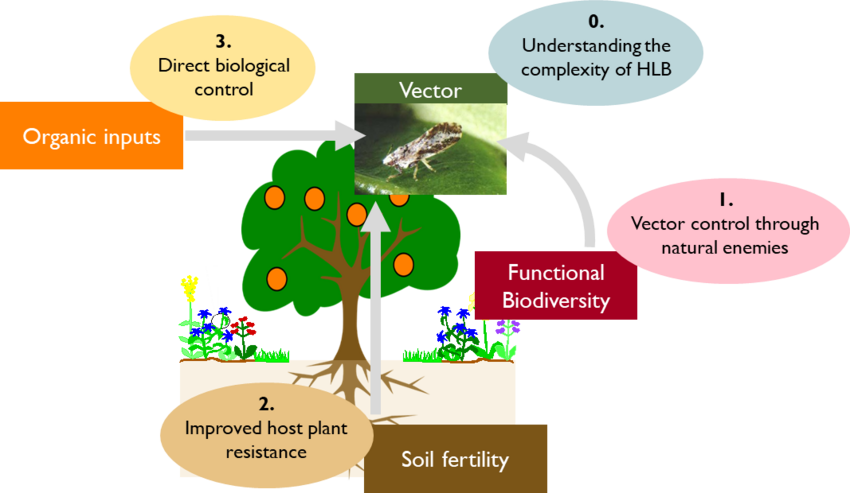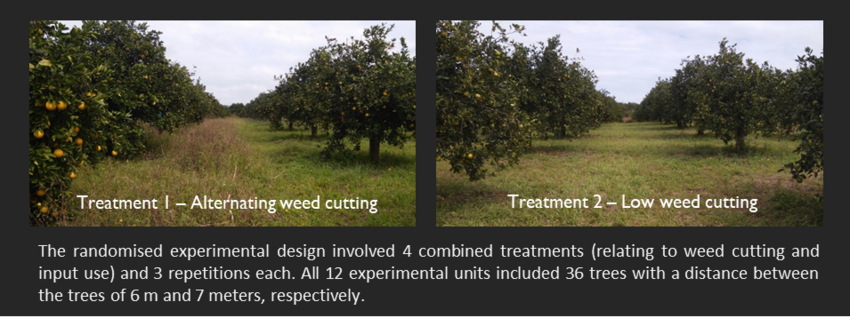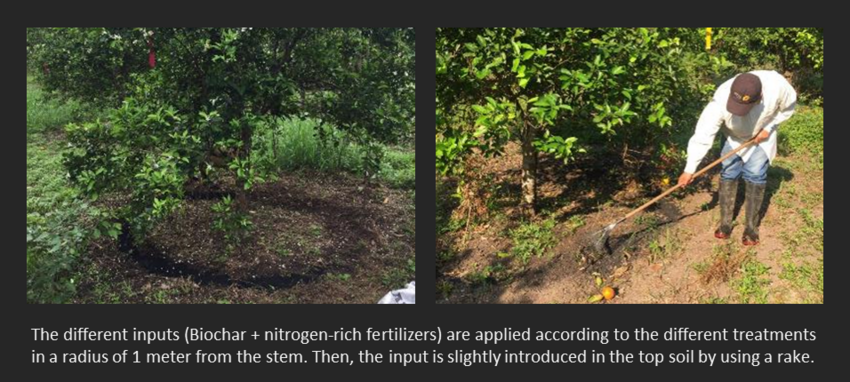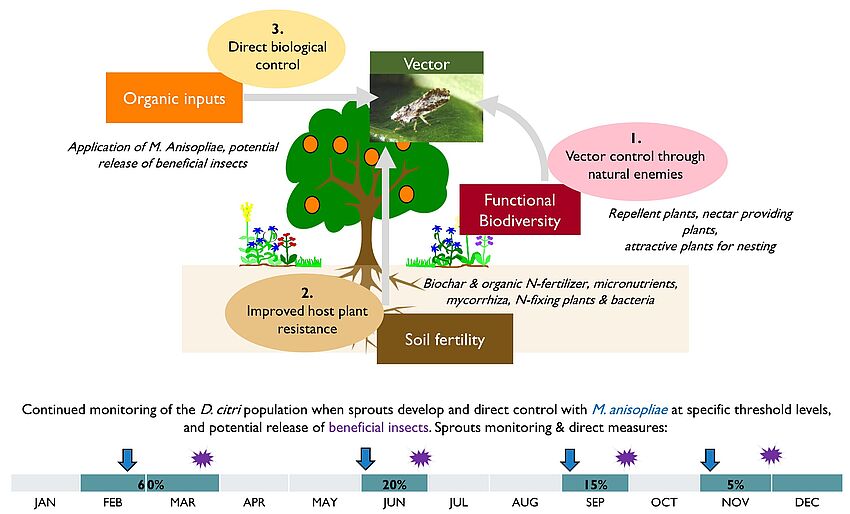Our Research
Background & research concept
Since 2007, the Coop supermarket in Switzerland, together with FiBL and local partners, started developing organic citrus production in Veracruz, Mexico, to obtain organic orange juice of excellent quality to be sold in Switzerland. With the first appearance of the HLB disease in Mexico in 2009, support became necessary to assist Mexican citrus producers in coping with this new disease. Thus, with additional financial support from the Coop Fund for Sustainability, FiBL enlarged its activities in Mexico in 2011 with an additional project on "integrated management of HLB in organic citrus orchards". At this stage, the prominent concern was that production would revert to conventional production due to the use of chemical pesticides to combat the vector of the HLB disease, as this has been happening in other citrus production regions (e.g. Brazil, Florida, Cuba, Costa Rica). From the beginning, the "Citrus Greening Program" has had two main objectives:
- To keep up the supply and quality of organic orange juice for export.
- To develop practical and viable solutions for organic citrus producers on how to successfully confront HLB and its vector with an integrated approach.
Project sites & partners
Initially, the program’s project site was based in the state of Veracruz, Mexico. In 2019, the region of Monterrey was added to allow work on two sites in Mexico with different climates, Veracruz having a humid subtropical climate and Monterrey with a hot semi-arid climate (being very similar to the Mediterranean citrus fruit production context). To further test and validate the program’s practices, FiBL would be interested in expanding the scope of the "Citrus Greening Program" and work with sites from other important citrus producing countries, e.g. Italy, Spain, Morocco, USA, Dominican Republic, and Brazil.
Currently, the program includes both private businesses and public entities as partners. On the business side, besides Coop, two organic juice producers and their supplying farmers are part of the program. Research partners include the Universidad Nacional Autonoma de Mexico, el Colegio de Posgraduados de Chapingo, and Ultraquimia Group. The latter is a private company involved in the elaboration and testing of organic agricultural inputs.
Our research concept
We promote an integrated management approach to directly and indirectly control HLB and its vector from an agro-ecosystem perspective. Thus, with different complementary measures, we aim to foster regeneration processes with organically managed orchards. By working directly with farmers and the private sector, most of the research is on-farm, and its results translate into practical measures for organic citrus production. With this scope, we interlink mainly three levels of interventions:
- Interventions that foster functional biodiversity, i.e. the diversity of flower and plant structures and insect populations (especially beneficial insects) that help control vector populations below a harmful threshold.
- Interventions that strengthen host plant resilience, i.e. by enhancing soil fertility aspects and water retention capacity to optimise plant nutrition and thus improve overall plant health and vigour (making the orchard more resistant to HLB infections).
- Interventions that relate to biological control, i.e. direct actions that harm and reduce the vector population using entomopathogenic fungi and the release of beneficial insects in critical moments of infestations (especially sprouting of vegetative parts of citrus trees) according to specific infestation thresholds.
As indirect and direct measures are combined to optimise results, each intervention must be properly analysed to determine its negative and positive effects - alone and when used in combination with others.
Main research components of the FiBL Citrus Greening Research Program

The program’s research
The program’s research concept involves four interlinked research areas:
- Research Area 0: Baseline knowledge to cope with a newly introduced and spreading disease
- Research Area 1: Functional biodiversity to control the vector population
- Research Area 2: Increasing host plant resilience with plant nutrition improvements
- Research Area 3: Biological control as a direct intervention to reduce the vector population
Research Area 0 – Baseline knowledge to cope with a newly introduced and spreading disease
- Assessment of farmer knowledge on HLB and control mechanisms - Between 2011 and 2014, researchers were in a similar position to farmers. During that time, farmers did not know the disease symptoms and its vector. They both had to deepen their understanding of the proliferation of HLB in plants, the occurring symptoms, and to what extent organic measures could help control the disease. Research action thus focused mainly on qualitative observations and aspects to better understand the HLB disease per se and how to cope with it successfully. A literature review was complemented with farmer interactions to understand the level of knowledge and derive potential action as part of an iterative and participatory process.
Results showed that farmer trainings on detecting HLB symptoms and observing the vector population were key to raising awareness and understanding among organic citrus producer regarding the "disease mechanisms". This was the basis for introducing a disease and vector monitoring system, serving as a decision-making tool to define direct control measures when the vector population is high. Furthermore, it became clear that eradicating host plants of D. citri did not lead to reduced infection rates.
Research Area 1 - Functional biodiversity and organic inputs to control the vector population
- Comparison study "organic" versus "conventional" - Given the gained insight that infestations rates were lower in more biodiverse orchards, between 2015 and 2018, a conventional orange orchard was compared to an organically managed orange orchard regarding how different ground cover management practices impact (a) the population of the vector (D. citri), (b) the abundance of other insects and the biodiversity composition of the ground cover. While conventional production involved using herbicides for weed control and synthetic insecticides to control D. citri, organic production involved a natural weed ground cover and weed cuttings three to four times a year. Moreover, a biopesticide based on plant extracts was used to fight D. citri.
Results showed that the organic orchard exhibits higher diversity of plant and arthropod species. Organic management favoured a shift towards species that are typical for the site's native vegetation. Also, the overall population of beneficial insects was higher than in the conventional orchards. All in all, the organically managed orange orchards had a D. citri population that was seven times lower than conventional orange orchards, suggesting that effective non-chemical weed management is an effective practice to control the pest and prevent the spread of the Huanglongbing (HLB) disease.
- On-farm experiment to study the impact of weed management and input use - From 2015 until 2019, an experiment was established to understand the impact of (a) different ways of weed cutting (i.e. "alternate cutting" versus "low cutting") and (b) the use of an organic input to reduce the D. citri population during the peak season (i.e. "with" versus "without input"). Four different combined treatments were set in place, while the insect diversity was monitored over time together with the D. citri population and disease appearance.
Results showed that alternate cutting with the use of the Metarhizium anisopliae (a fungus strain) to control the D. citri population was the most effective combined treatment to control the vector and thus reduce HLB infestations. The alternate cutting promoted the proliferation and preservation of local plants, which proved to be especially relevant for beneficial insects (providing constant feed and nesting opportunities). Thereby, especially plants with diverse plant structure seemed to offer relevant niches for beneficial insects. Furthermore, the alternate cutting involved a higher number of fruits and yield levels. In the case of low cutting, fruit losses were correlated with the occurrence of anthracnose - alternate cutting seemed to protect the plant against anthracnose.
- Validation of weed management practices in a network of seven pilot orchards - To complement and validate the on-farm experiment, between 2018 and 2020, the same management treatments ("alternate cutting", "low cutting", "input use") were also used in seven pilot orchards and then compared with data collected from farms where common organic and conventional farming practices are used.
Results confirmed that alternating cuttings in combination with Metarhizium anisopliae application during the citrus sprouting season (around February-March, June-July, October-November) is indeed the best way to control D. citri in comparison to conventional chemical treatments. This positive outcome was consistent across all orchards given the fact that alternate weed cutting involved a higher number of vegetative shoots, more fruit set, better yields, and fewer applications in regulating D. citri. Lower treatment costs coupled with increased tree productivity had a meaningful impact on profitability.
Illustration of the two weed management treatments as part of the experimental design

- Ongoing activities since 2020 - As part of a new program phase, research activities are underway, for which practice-relevant findings are expected until 2024. These include:
- "Stress test" of alternating cutting - This promising technology is tested in areas with a very high infestation of D. citri in both organically and conventionally managed orchards.
- Assessment of selective weeding - The contribution of different native and composite plants is assessed concerning their capacity to functionally increase the population density of beneficial insects as part of improved biodiversity.
Research Area 2 - Increasing host plant resilience with plant nutrition improvements
A viable strategy to reduce plant diseases relates to improved plant resistance, i.e. making the host plant less susceptible to infections. In view of identifying options in this regard, the following activities were implemented:
- Testing of different induce resistances and evaluating their effects on D. citri - From 2015 to 2016, two commercial products Barrier® and Resistent® were tested as part of a field experiment to evaluate their effect on D. citri against other inputs to control this vector. In parallel, both inputs were also tested under laboratory conditions, applying different amounts, the causal effects were studied on how the vector was affected by the involved (toxic) substances. Measurements included: the induction of repellency in spray-treated plants, mortality and fecundity of treated adults, survival of treated eggs and nymphs, development of survivors and their size, and the sex ratio of survivors.
Field experiment results showed that Barrier® and Resistent® had positive effects on reducing the D. citri population as well on diminishing the important diseases anthracnosis (Colletotrichum acutatum) and grey spot (Mycosphaerella citri). However, under laboratory conditions, both products generated highly undesired effects. The sublethal effects of these silicon-based products led to abnormal physiological development of D. citri (e.g. increased size of thorax and wings, increased oviposition rate).
- Literature review to identify most promising organic options to enhance plant resistance - Existing research articles on the topic of induced HLB resistance were reviewed, relating to numerous organic, inorganic substances, plant extracts, microorganisms or mineral products that were described to induce resistance.
Survey results confirmed that enhancing host plant resistance through improved nutrient uptake is a viable strategy to reduce infection susceptibility and pathogen levels. Mycorrhiza seems to have a promising potential among microorganisms as they tend to improve nutrient availability and thus uptake. This improves overall plant health, i.e. making trees stronger and less susceptible to diseases. Furthermore, some micronutrients tend to influence the bacteria contained within the plant, presumably due to the change of pH in the sap.
- Biochar applications to improve plant resistance as a means to lower HLB infection rates - Since 2019, special field trials have been set up to assess the impact of different biochar treatments on HLB infections. Altogether, 11 different treatments were applied, relating to different amounts and types of biochar, each charged with different amounts of nitrogen-rich organic fertilisers.
Up to now, results are highly astonishing and positive: those treatments involving higher application of biochar charged with nitrogen-rich organic fertiliser had a much better impact on the D. citri population, respectively lower level of infestations, than all other treatments. These results correlated with higher levels of chlorophyll found in citrus leaves when applying these treatments. Furthermore, where biochar charged with nitrogen fertiliser was applied, trees produced a higher number of flowers and more fruits developed due to a lower infestation of anthracnose and, subsequently, lower abortion rate.
- Ongoing activities since 2021 - To further explore the potential of biochar and other means to improve nutrient uptake within the orchard, the following activities are underway:
- "Stress test" relating to improved plant nutrition strategies - New trials are being implemented in orange orchards with high D. citri infestation and advanced HLB symptoms. In one trial, the influence of combined biochar applications (with organic fertiliser and biofertiliser, such as bacteria and mycorrhizas) will be assessed regarding plant health. In another trial, the effect of seven foliar-applied micronutrients will be evaluated for this same objective.
- Assessing the potential of improved cover crops - As a means to further increase soil fertility and increase the availability of nutrients (especially nitrogen) within the orchard, different leguminous cover crops will be evaluated on their potential to foster tree growth and health.
Research Area 3 – Biological control as a direct intervention to reduce the vector population
Complementary, direct biocontrol measures were tested, involving both biological insecticides (i.e. botanicals, mineral products) and living biocontrol organisms (i.e. micro or macro-organisms)
- Assessing immediately available products - As a first attempt, from 2012 to 2015, field trials were carried out to determine which available commercial organic inputs could be used to control the D. citri population. For that, already commercially available products in Mexico were applied and tested concerning their effectiveness.
The testing of commercial biopesticides for direct D. citri control was only partly successful. The used commercial inputs also disrupted the population of beneficial insects, such that the vector populations could not be effectively reduced over time.
- Testing of different direct control measures - From 2018 to 2019, different greenhouse and laboratory tests were conducted to verify if there are alternative agents to effectively control the vector (D. citri) directly. Thereby, 23 different commercial and non-commercial (including organic) inputs were tested, evaluating, first, the effects on the vector’s mortality and undesirable effects on D. citri (e.g. resistance of the vector to the inputs) and, second, the impact of these inputs on potential beneficial insects: i.e. parasitoid Tamarixia radiata and predatory species as Chrysoperla spp (lacewing) and Coccinelidae, whose most frequent representatives are the lady beetles (Coleomegila maculata and Olla nigrum).
Results showed that from the 23 inputs, six products were lethal for D. citri. Consequently, for these inputs, potentially adverse effects on D. citri were studied. From those, only Metarhizium anisopliae, an entomopathogenic fungus, and Spintor had no adverse side effects on the vector.
- Determination of a sampling methodology to assess D.citri infestations – Field data obtained during 2016 and 2017 on the monitoring of the population of D. citri was used to develop and validate a decision-making tool for farmers to support them with Metarhizium anisopliae treatment applications. Based on statistical assessments considering an an infestation threshold of 5%, the number of vegetative shoots to be sampled was derived.
Calculations revealed that sampling would need to involve 50 shoots per orchard of 5 ha to still be able to determine if infestations are above or below the threshold. It was recommended that farmers apply Metarhizium anisopliae if three infested shoots are found from the overall 50 shoot sample.
- Ongoing activities since 2020 - As part of a new program phase, research activities are underway, for which practice-relevant findings are expected until 2024. These include:
- Evaluation of effects of M.anisopliae on beneficial insects - With lab experiments, larvae of Chrysoperla carnea are confronted with the fungus M. anisopliae.
- Release of Chrysoperla carnea larvae on field trials - With this experiment, the direct effects of released Chrysoperla carnea larvae on the D. citri population is studied.
Overall conclusions & promising innovations to fight HLB in organic citrus production
Up to now, we can derive the following conclusions from our work, which are all meaningful puzzle pieces in shaping a feasible strategy to mitigate and fight HLB in the coming years:
- Alternated weed cutting is a highly valid concept. It is an excellent alternative for common ground cover management, reducing the amount of labour required for weed management by 50% while upgrading the natural habitat for beneficial insects, helping to drastically reduce the HLB vector population (i.e. D. citri). This type of weed management has no adverse effects on crop yields, given the fact that this practice helps to better regulate soil moisture compared to low cuttings or when herbicides are applied.
- Good plant nutrition is vital when confronting HLB, improving citrus plants resilience to infections. Thereby, strategies that enhance continuous nutrient uptake through improved soil fertility are more promising than conventional fertilisation practices. As a means to improve soil structure linked to water and nutrient holding capacity, the use of biochar combined with organic fertilisers (and potentially biofertilisers) is highly promising.
- Direct vector control is a still meaningful complementary practice in areas with high(er) D. citri infestations, but which needs to be well implemented: based on an action threshold according to vector population monitoring and timely use of effective microorganisms, such as the entomopathogenic fungus Metarhizium anisopliae. When applied in critical moments of tree growth (when sprouting), the proliferation of the D. citri population can be successfully prevented.
Outlook & way forward
The ongoing work very much builds on the promising findings mentioned above. Yet, consolidating these findings from a scientific standpoint and relating them to more contexts, we are eager to find partners willing to join forces in validating these innovations together. Thereby, we will have a closer look at the economic implications these technologies have for farmers (i.e. cost-benefit analysis). As we must anticipate that HLB is likely also to reach Europe in the coming years, we are interested in collaborating with institutions fostering organic management practices in citrus growing regions, especially in Spain and Italy.


 tap and then scroll down to the Add to Home Screen command.
tap and then scroll down to the Add to Home Screen command.